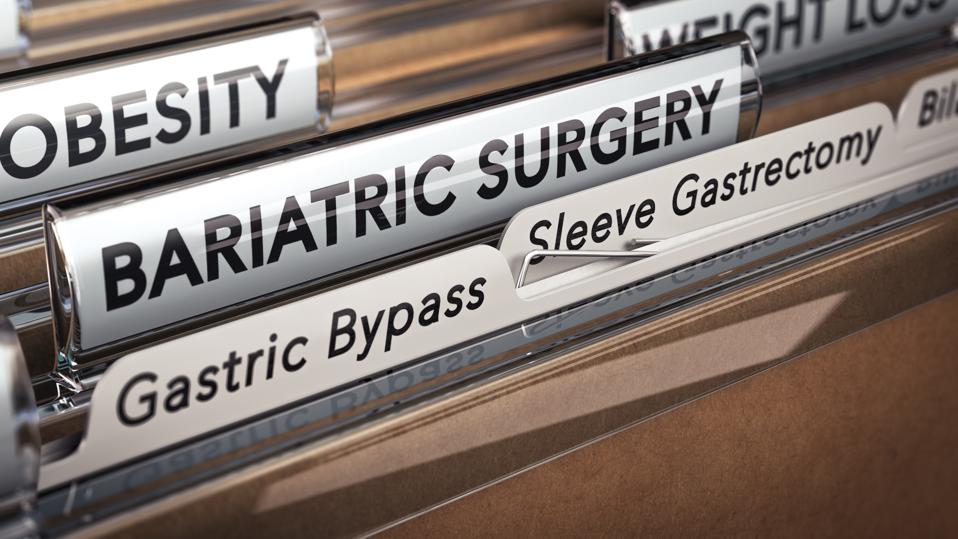Topline
The results of the first human trial examining a new weight loss procedure called gastric mucosal ablation were released Thursday, and the non-surgical procedure caused minimal side effects with a short outpatient recovery period compared to other weight loss procedures, though the amount of weight lost was less.
Key Facts
The researchers followed 10 female participants with an average age of 38.4 years, and average BMI of 40.2 (obesity is defined as a BMI of 30 or above) over a six-month period between November 2022 and April 2023.
Each participant underwent the endoscopic procedure called gastric mucosal ablation, which involves inserting a fluid cushion to protect the stomach lining before using a tiny device to burn the gastric fundus—the lining of the upper portion of the stomach.
The hunger hormone called ghrelin is mainly stored in the gastric fundus and the production of ghrelin leads to increased feelings of hunger, so burning the gastric fundus reduces ghrelin production, thus leading to less food consumption.
The participants lost an average of almost 8% of their body weight within six months, totaling around 19 pounds on average, decreased their ghrelin production by 45%, decreased their stomach capacity by 42% and reduced their hunger cravings and appetite by 43%.
The participants didn’t experience any severe adverse events, only minimal side effects like gas pressure, mild nausea and cramping, which lasted between one and three days, Dr. Christopher McGowan, the study’s lead author and a gastroenterologist and medical director of the medical clinic True You Weight Loss, said during a media briefing.
The procedure took an average of 55 minutes and all participants underwent it on an outpatient basis—meaning they didn’t require hospitalization afterward—so they were able to leave and go home within an hour after the procedure.
How Does Gastric Mucosal Ablation Compare To Other Weight Loss Procedures?
Gastric mucosal ablation is considered a minimally invasive surgical option because it only burns the gastric fundus, while other invasive procedures like gastric sleeve and bypass involve removing or bypassing the gastric fundus—making a new pouch in the stomach and connecting it to the intestines. “For patients who are fearful of surgical complications, these minimally invasive techniques may represent a more acceptable treatment option,” McGowan told Forbes.
- Side effects: Though there’s not much research on the long-term side effects of gastric mucosal ablation, they appear to be less severe than other procedures. Complications from surgical procedures like the gastric sleeve and gastric bypass include infection, excess bleeding, blood clots, stomach leakage, lung or breathing problems, hernias, vomiting, low blood pressure and vitamin deficiencies. Lap band complications include nausea, vomiting, band erosion, obstruction of the outlet between the stomach and pouch, acid reflux, difficulty swallowing, widening of the pouch and excess scar tissue around the band. The gastric balloon and the endoscopic sleeve gastroplasty—which are other minimally invasive procedures—have side effects like nausea, indigestion, constipation and acid reflux, bleeding, infection, abscess, stomach leakage, collapsed lungs, blood clots in the lungs and gas or air in the abdominal cavity.
- Recovery time: Compared to gastric mucosal ablation, which took an average of 55 minutes to complete and required the avoidance of strenuous activities for the next three to five days, the gastric sleeve takes between 40 to 70 minutes to complete, the bypass takes two to three hours and the lap band takes between one to two hours. It’s recommended patients take between a one and two week recovery period after getting the lap band before returning to work, while the gastric sleeve and bypass requires a two to four week recovery period. The gastric balloon takes 20 to 30 minutes to insert and requires a one to three day recovery period. The ESG takes between one and three hours to complete and requires a recovery period of one to three days.
- Weight loss: Weight loss results from the gastric mucosal ablation trial were less significant than other methods. Patients typically lose 50%-60% of their excessive body weight within the first six months of the gastric sleeve, they lose between 30% and 40% of their body weight within the first six months of the gastric bypass and patients lose one to two pounds a week after getting the lap band, so that equates to 25-50 pounds after six months. Patients lose around 16.6% of their total body weight within the first months of getting ESG, and between 6% and 15% from the gastric balloon.
Crucial Quote
“It could be an additional option for patients who don’t want or aren’t eligible for anti-obesity medications, such as Wegovy and Ozempic, or bariatric surgery,” McGowan said of gastric mucosal ablation in a statement.
Big Number
1 billion. That’s how many people worldwide have obesity, according to recent research published in the Lancet. That includes 879 million adults and 159 million children.

